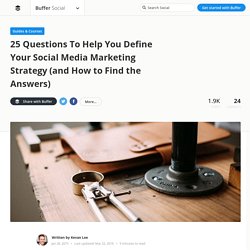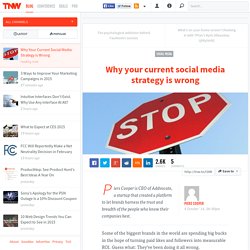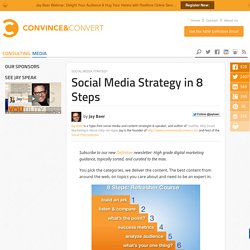

ANCHOVY Team Alvimedica Case Study. Maslow’s Hierarchy of Needs for Social Media Marketing. How To Create A Social Media Marketing Plan In 6 Steps. Why Nordstrom’s Digital Strategy Works (and Yours Probably Doesn’t) In a recent MIT CISR poll, 42% of our respondents said they expected to gain competitive advantage from social, mobile, analytics, cloud, and internet of things (SMACIT) technologies.

But guess what? That’s not going to happen. The most notable characteristic of those technologies is their accessibility — to customers, employees, partners, and competitors. Because they are so accessible, it is very difficult to generate competitive advantage from any of them. That doesn’t mean you can ignore them. Only a small percentage of companies will gain competitive advantage from SMACIT technologies. Take the large retailer Nordstrom. Then, between 2004 and 2014, Nordstrom made an extraordinary series of investments, each aimed squarely at that same purpose of providing a fabulous customer experience. 25 Questions to Help Define Your Social Media Strategy. Whether you’re starting a social media marketing plan from scratch or redefining an existing social media strategy, we’ve found that taking a moment to reflect on some key questions can be a really valuable exercise.

These Big Important questions—capital “B,” capital “I”—can help point you down the best path with your social media efforts and ensure that the time you spend is aimed at the right places and toward your top goals. I’ve listed here 25 of the questions that I’ve found most helpful when coming up with social media strategies for my personal brand and for sharing with Buffer. Plus, I’m happy to share how I think about answering these questions as well. It’d be great to hear your thoughts and experience on the topic, too!
Why Your Current Social Media Strategy is Wrong. Piers Cooper is CEO of Addvocate, a startup that created a platform to let brands harness the trust and breadth of the people who know their companies best.

Some of the biggest brands in the world are spending big bucks in the hope of turning paid likes and followers into measurable ROI. Guess what: They’ve been doing it all wrong. They jumped into the deep end of the social pool as brands, not as the people behind the brands. KLM: We make €25m per year from social media. When trying to improve your digital marketing skills it’s advisable to learn from the best in the business.

Social Media Strategy in 8 Steps. Subscribe to our new Definitive newsletter: High grade digital marketing guidance, topically sorted, and curated to the max.

You pick the categories, we deliver the content. The best content from around the web, on topics you care about and need to be an expert in. Social Media Strategies in 2014. Shared By Plus Subscriber Joakim Nilsson This is Baekdal Plus content.

It is shared with you for free by a member. 7 insights into social strategy at The Economist. The Economist's Mark Johnson encourages others to experiment beyond the main social media platforms Credit: By Horia Varlan on Flickr.

Some rights reserved. The Economist is celebrating 170 years since its first edition hit the presses in September 1843. And while the newspaper remains committed to its founding mantra "to take part in a severe contest between intelligence, which presses forward, and an unworthy, timid ignorance obstructing our progress", its efforts to do so are of course no longer limited to print. The Economist website recently recorded "around 1.6 million" monthly unique US visitors, according to a Mashable report which cited ComScore statistics, while its continental Europe digital edition secured the highest circulation for a magazine digital edition in the first half of 2013, according to the Audit Bureau of Circulation. 1.
And these activities work in tandem with its own platforms. 2. He advises others to branch out beyond Facebook and Twitter. 4. 5. 6. 7. How to integrate objectives and strategy when creating a marketing plan. Lack of integration between goals, strategies and tactics is a problem I often find when reviewing online marketing strategies.

This is true whether I’m reviewing student assignments or mentoring marketers creating real-world digital strategies. This happens simply because the different aspects of strategy often aren’t well integrated because of the way the report is split up into separate sections. Although online marketing strategies are usually well structured, for example into PR Smith’s SOSTAC® structure featured in our free online marketing strategy template, the sections aren’t often well related.
It’s not clear how each strategy is supporting a goal or the analysis on which the objective is based. How to use social data across your business. However, in more instances than ever before, social data is also being used in other areas of the business, and social media has evolved from just being a vehicle for marketing.

‘Social business’ and ‘social across the enterprise’ are now commonplace phrases in modern business terminology. Why become a social business? Social media is changing the way people connect, and is changing the relationship between consumers and brands. Building the social enterprise. Why do so few companies capture the full value of social technologies?

There’s no doubt organizations have begun to realize significant value from largely external uses of social. Yet internal applications have barely begun to tap their full potential, even though about two-thirds of social’s estimated economic value stems from improved collaboration and communication within enterprises. Although more than 80 percent of executives say their companies deploy social technologies, few have figured out how to use them in ways that could have a large-scale, replicable, and measurable impact at an enterprise level. Just over a quarter of executives say that their companies have significantly incorporated social technologies into the day-to-day work flow by, for example, adapting internal structures, systems, processes, and practices to the greater connectedness they enable.
Companies are missing a potentially huge prize. The digital enterprise. It’s safe to assume virtually all companies use digital technology in some form or another. Yet getting beyond obvious and small applications of technology to drive the creation of truly “digital enterprises” is vital—and presents a challenge for executives. In this video interview, McKinsey director Paul Willmott explains the opportunities and threats posed by the evolution of digital technology, why becoming a digital enterprise is critical, and what leaders should do. What follows is an edited transcript of his remarks. Interview transcript A technology explosion. [Slides] The 2014 State of Digital Transformation by Altimeter Group.